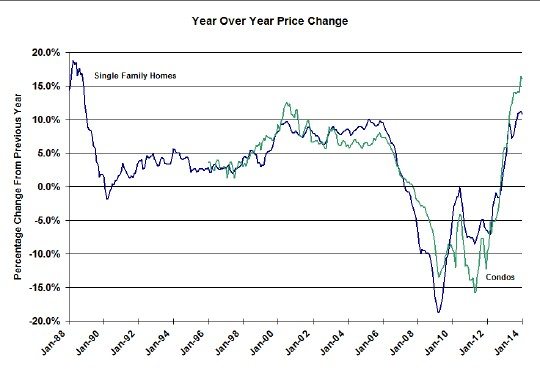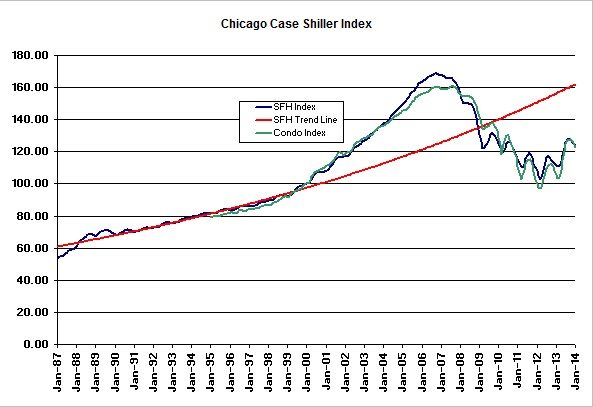You would think that after years of being hit with the last Tuesday of the month rush on their Web site S&P Indices would be able to get the Case Shiller home price index data posted by 8 AM as promised. However, inundated with traffic, they didn’t get all their data posted until around 9 AM. Messed up my whole morning. But when the dust finally settled we found out that Chicago home prices drifted down slightly in January as they typically do. No big deal.
This morning’s report is entitled Pace of Home Price Gains Slow, which references the national picture and pretty much sums up the current housing market. For Chicago single family home prices were up 10.8% over the previous year and condominium prices were up 16.1% but these numbers are down from the year over year gains noted for 2013 as a whole. The drop is so small you can barely make it out in the graph below.
From December to January single family home prices fell by 1.2% and condominium prices fell by 2.4%. That’s one of the larger price drops for condominiums in the last 2 years. So this puts us back to the levels that both indices last hit in September/ October 2010. On the way up single family home prices were at this level in August 2002 and condominium prices hit this level in June 2002.
Of course these seasonal dips put us further away from getting back to our bubble peak. Single family home prices are now 26.6% below the peak, while condo prices are 23.6% below the peak. We’ve still gained some ground though from the bottom of the market. Single family home prices have appreciated by 20.4% and condos have appreciated by 29.5%.
But to put things in a slightly more realistic perspective…compare where we are now to the long term trend line in the graph below – we are running 23.7% below that level. Interestingly, that long term trend line still has months to go before it also reaches the bubble peak.
S&P’s report tries to makes sense out of the slight decline in home prices across the nation, blaming it on the weather but the fact of the matter is that a decline at this time of the year is normal and you can’t make too much out of a single data point. They also point out that Chicago and Seattle had the largest one month declines in the group of 20 metro areas tracked. However, the fact of the matter is that in the big picture – year over year prices – the market still looks pretty darn good.
In providing perspective on the national picture, David M. Blitzer, Chairman of the Index Committee at S&P Dow Jones Indices, expressed reserved optimism:
Expectations and recent data point to continued home price gains for 2014. Although most analysts do not expect the same rapid increases we saw last year, the consensus is for moderating gains. Existing home sales declined slightly in February and are at their lowest level since July 2012.
If you want to keep up to date on the Chicago real estate market, get an insider’s view of the seamy underbelly of the real estate industry, or you just think I’m the next Kurt Vonnegut you can Subscribe to Getting Real by Email. Please be sure to verify your email address when you receive the verification notice.

